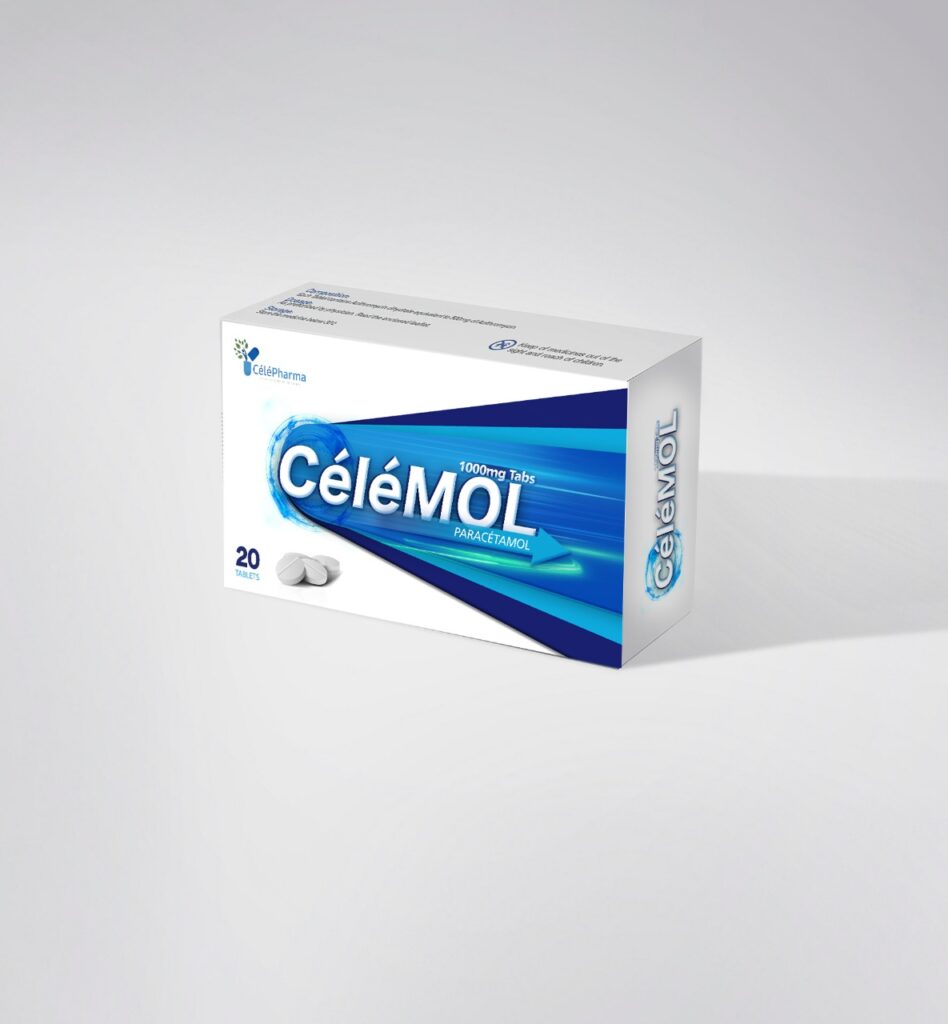CeleMol 1000mg Tablets
Dosage Form
Tablets
Composition
Each uncoated tablet contains :
Paracetamol B.P. 1000 mg
Pharmacology
Pharmacotherapeutic group: Other analgesics and antipyretics, Anilides
ATC code N02B E01
Paracetamol has analgesic and antipyretic properties but it has no useful anti-inflammatory properties.
Paracetamol’s effects are thought to be related to inhibition of prostaglandin synthesis.
Pharmacokinetics
Absorption
Paracetamol is readily absorbed from the gastrointestinal tract.
Distribution
Peak plasma concentrations occur about 10 to 60 minutes after oral doses. Paracetamol is distributed into most body
tissues. It crosses the placenta and is present in breast milk. Plasma-protein binding is negligible at usual therapeutic
concentrations but increases with increasing concentrations.
Biotransformation
It is metabolised in the liver. A minor hydroxylated metabolite which is usually produced in very small amounts by
mixed-function oxidases in the liver and which is usually detoxified by conjugation with liver glutathione may
accumulate following Paracetamol overdosage and cause tissue damage.
Elimination
It is excreted in the urine, mainly as the glucuronide and sulfate conjugates. The elimination half-life varies from
about 1 to 4 hours.
Indications
Paracetamol has analgesic and antipyretic actions similar to those of aspirin and hence is a suitable alternative for
patients sensitive to aspirin.
For the relief of mild to moderate pain and febrile conditions, eg headache, toothache, colds, influenza, rheumatic
pain and dysmenorrhoea.
Paracetamol tablets are indicated in adults and children aged 10 to 18.
Dosage & Administration
Adults including the elderly and children over 16 years: One to two tablets every 4-6 hours as required, to a
maximum of 8 tablets daily in divided doses.
Children 10-15 years: One tablet every 4-6 hours as necessary to a maximum of 4 doses in 24 hours.
Children under 10 years: Not recommended for children under 10 years of age. Alternative presentations of
Paracetamol are recommended for paediatric usage in order to obtain suitable doses of less than 500mg
Contraindications:
Hypersensitivity to the active substance or to any of the excipients
Special warning & Precautions
Where analgesics are used long-term (>3 months) with administration every two days or more frequently, headache
may develop or worsen. Headache induced by overuse of analgesics (MOH medication-overuse headache) should
not be treated by dose increase. In such cases, the use of analgesics should be discontinued in consultation with the
doctor.
Care is advised in the administration of Paracetamol to patients with alcohol dependency (see section 4.9), severe
renal or severe hepatic impairment. The hazards of overdose are greater in those with non-cirrhotic alcoholic liver
disease.
Label Warnings:
Do not exceed the recommended dose
If symptoms persist consult your doctor
Keep out of the sight and reach of children
Do not take with any other Paracetamol-containing products.
Immediate medical advice should be sought in the event of an overdose, even if you feel well, because of the risk of
delayed, serious liver damage.
or if leaflet present:
Immediate medical advice should be sought in the event of an overdose, even if you feel well.
Drug-Interactions
Anticoagulants – the effect of warfarin and other coumarins may be enhanced by prolonged regular use of
Paracetamol with increased risk of bleeding. Occasional doses have no significant effect.
Metoclopramide – may increase speed of absorption of Paracetamol.
Domperidone – may increase speed of absorption of Paracetamol.
Colestyramine – may reduce absorption if given within one hour of Paracetamol.
Imatinib – restriction or avoidance of concomitant regular Paracetamol use should be taken with imatinib.
Pregnancy & Lactation
Pregnancy
A large amount of data on pregnant women indicate neither malformative, nor feto/neonatal toxicity.
Epidemiological studies on neurodevelopment in children exposed to Paracetamol in utero show inconclusive
results. If clinically needed, Paracetamol can be used during pregnancy however it should be used at the lowest
effective dose for the shortest possible time and at the lowest possible frequency.
Breast-feeding
Paracetamol is excreted in breast milk but not in a clinically significant amount. Available published data do not
contraindicate breast feeding.
Side effects
Adverse effects of Paracetamol are rare but hypersensitivity including skin rash may occur. There have been reports
of blood dyscrasias including thrombocytopenia, neutropenia, pancytopenia, leukopenia and agranulocytosis but
these were not necessarily causality related to Paracetamol
Very rare cases of serious skin reactions have been reported.
Overdosage
Liver damage is possible in adults who have taken 10g or more of Paracetamol. Ingestion of 5g or more of
Paracetamol may lead to liver damage if the patient has risk factors.
Symptoms of Paracetamol overdosage in the first 24 hours are pallor, nausea, vomiting, anorexia and abdominal
pain. Liver damage may become apparent 12 to 48 hours after ingestion. Abnormalities of glucose metabolism and
metabolic acidosis may occur. In severe poisoning, hepatic failure may progress to encephalopathy, haemorrhage,
hypoglycaemia, cerebral oedema, and death. Acute renal failure with acute tubular necrosis, strongly suggested by
loin pain, haematuria and proteinuria, may develop even in the absence of severe liver damage. Cardiac arrhythmias
and pancreatitis have been reported.
Management
Immediate treatment is essential in the management of Paracetamol overdose. Despite a lack of significant early
symptoms, patients should be referred to hospital urgently for immediate medical attention.
Symptoms may be limited to nausea or vomiting and may not reflect the severity of overdose or the risk of organ
damage. Management should be in accordance with established treatment guidelines, see BNF overdose section.
Storage
Store the medicine below 30 C
Presentation:
20 Tablets

